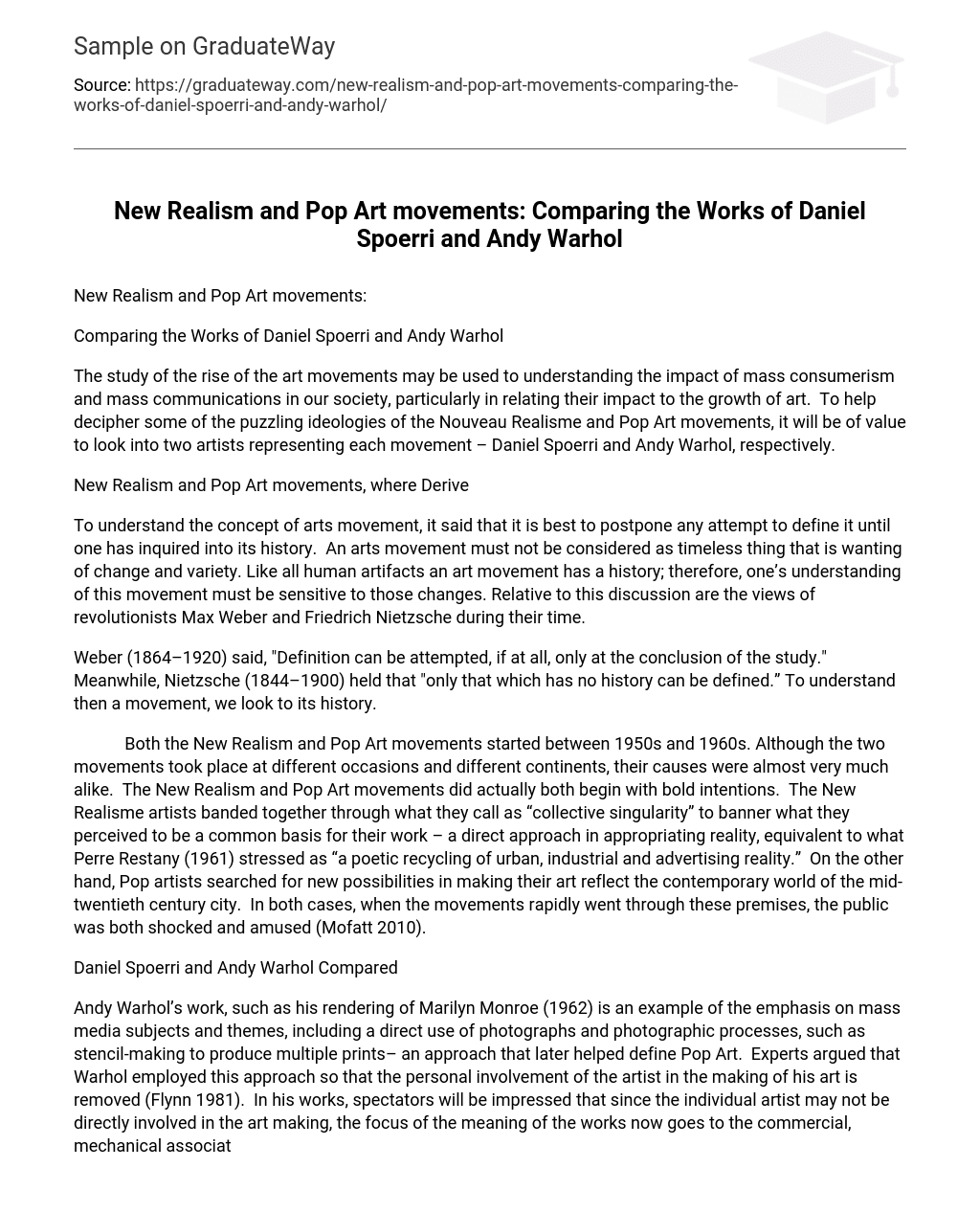New Realism and Pop Art movements:
Comparing the Works of Daniel Spoerri and Andy Warhol
The study of the rise of the art movements may be used to understanding the impact of mass consumerism and mass communications in our society, particularly in relating their impact to the growth of art. To help decipher some of the puzzling ideologies of the Nouveau Realisme and Pop Art movements, it will be of value to look into two artists representing each movement – Daniel Spoerri and Andy Warhol, respectively.
New Realism and Pop Art movements, where Derive
To understand the concept of arts movement, it said that it is best to postpone any attempt to define it until one has inquired into its history. An arts movement must not be considered as timeless thing that is wanting of change and variety. Like all human artifacts an art movement has a history; therefore, one’s understanding of this movement must be sensitive to those changes. Relative to this discussion are the views of revolutionists Max Weber and Friedrich Nietzsche during their time.
Weber (1864–1920) said, “Definition can be attempted, if at all, only at the conclusion of the study.” Meanwhile, Nietzsche (1844–1900) held that “only that which has no history can be defined.” To understand then a movement, we look to its history.
Both the New Realism and Pop Art movements started between 1950s and 1960s. Although the two movements took place at different occasions and different continents, their causes were almost very much alike. The New Realism and Pop Art movements did actually both begin with bold intentions. The New Realisme artists banded together through what they call as “collective singularity” to banner what they perceived to be a common basis for their work – a direct approach in appropriating reality, equivalent to what Perre Restany (1961) stressed as “a poetic recycling of urban, industrial and advertising reality.” On the other hand, Pop artists searched for new possibilities in making their art reflect the contemporary world of the mid-twentieth century city. In both cases, when the movements rapidly went through these premises, the public was both shocked and amused (Mofatt 2010).
Daniel Spoerri and Andy Warhol Compared
Andy Warhol’s work, such as his rendering of Marilyn Monroe (1962) is an example of the emphasis on mass media subjects and themes, including a direct use of photographs and photographic processes, such as stencil-making to produce multiple prints– an approach that later helped define Pop Art. Experts argued that Warhol employed this approach so that the personal involvement of the artist in the making of his art is removed (Flynn 1981). In his works, spectators will be impressed that since the individual artist may not be directly involved in the art making, the focus of the meaning of the works now goes to the commercial, mechanical associations.
On the other hand, Daniel Spoerri is credited for developing the idea of the detrompe-l’oeil, whereby his approach combines the classic illusionist picture with objects whose function is to demystify this image until such object, such as a “chromo” earns a commonplace status. This intention of relegating to commonplace status classic pictures is a direct contrast to the Pop Art movement’s mantra that tend to favor commonplace images (like Warhol’s Campbell’s soup cans) and impersonal media such as the seriograph (Flynn 1981).
In sum, works by Nouveau Realism and Pop Art movements may be similar yet different in many ways. Both may be similar in terms of the purpose to present object as it is chosen by the artist. Their main difference, however, lies in the kind of media they use and their purpose in relegating objects in the society.
Works Cited
Censer, J.R. Amalgamating the social in the French Revolution. Journal of Social History. September 22, 2003. Web. March 5, 2010.
Flynn, Patricia. Pop Art-Reflections of the Mass Media. Yale University. Web. 6 March 2010.
Heron, Liz. New Realism. Centre Pompidou, Direction de l’action éducative et des publics.
Web. 6 March 2010.
Moffat, Charles. Art based on Popular Culture. Lilith Gallery. Web. 6 March 2010.
Prokopyev, O. Conceptualizing electoral revolutions: challenges and promises. Web. 6 March 2010.
Restany, Pierre. À 40º au-dessus de Dada, the introduction to the catalogue of the exhibition, at
Galerie J, 8 rue Montfaucon, Paris 6e. 17 May-10 June 1961. Web. 6 March 2010





